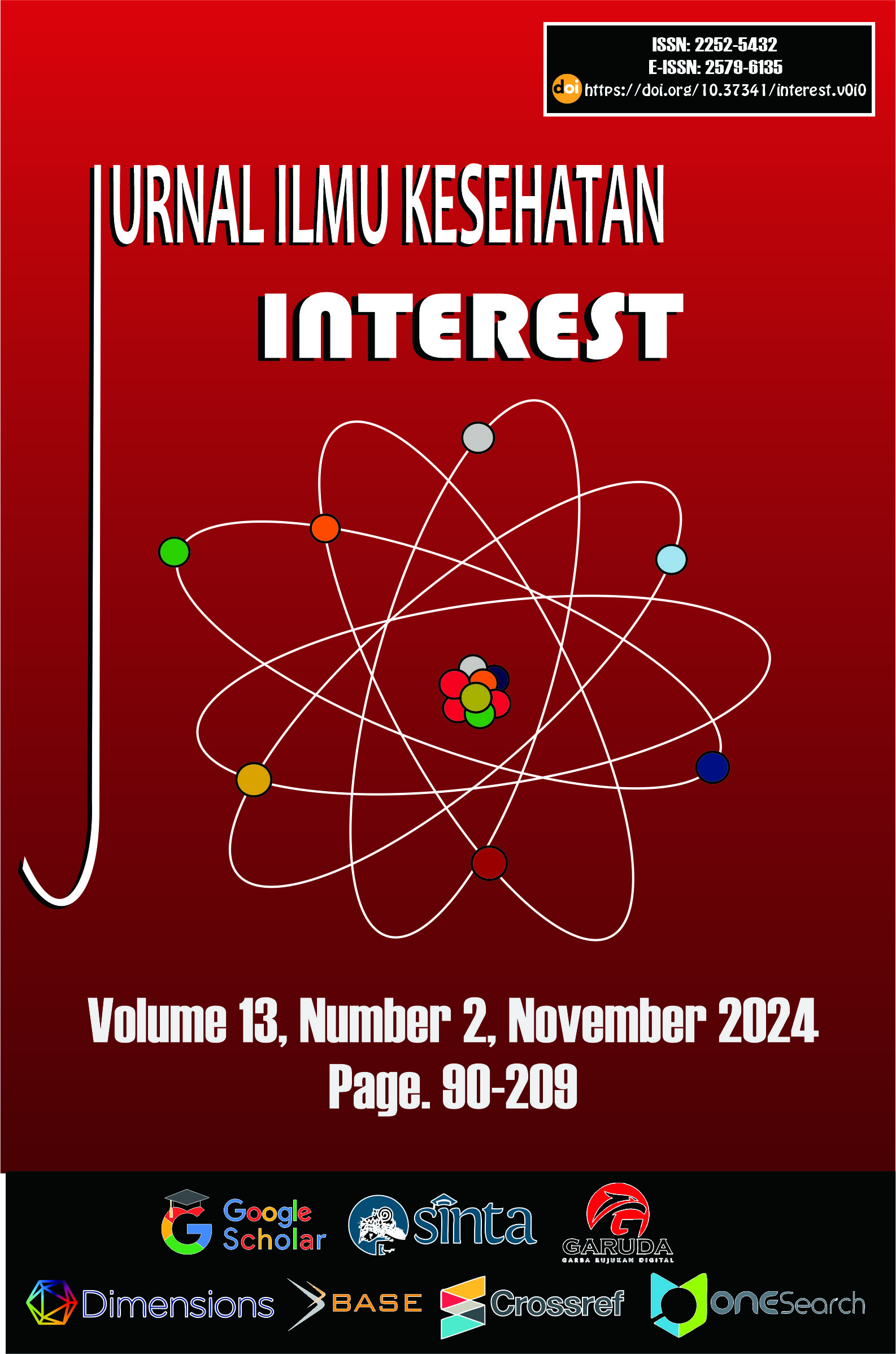Telehealth Model Strategy to Improve Maternal Feeding Practices in Children with Stunting: Randomized Control Trial
Main Article Content
Abstract
Background: The eating behaviour of the stunted children is the high risk for their growth and development. Given the urgency of all the impacts caused and its high prevalence, handling stunting through changes in feeding patterns requires serious attention from the government, society, and individuals as a whole. This study utilises telehealth as an innovative solution to overcome the challenges in feeding children with stunting. The aim of this study is to improve maternal feeding practices for children with stunting using telehealth.
Methods: This study uses the single-blind randomised controlled trial method. The sampling method in this study was by using purposive sampling. The participants of this study are 41 mothers who have a child with stunting.
Results: There was a significant effect (p=0.169) of the Telehealth Model Strategy to Improve Maternal Feeding Practices in Children with Stunting.
Conclusion: We found that the telehealth model can be used to improve maternal feeding practices for children with stunting using telehealth.
Article Details
References
Aguayo, V. M., & Menon, P. (2016). Stop stunting: Improving child feeding, women’s nutrition and household sanitation in South Asia. Maternal and Child Nutrition, 12, 3–11. https://doi.org/10.1111/mcn.12283
Aswati, A., Agus Supiganto, Halid, S. H., Melati Inayati Albayani, & Henny Yolanda. (2023). Gambaran Pengetahuan Tugas Keperawatan Keluarga dan Upaya Pencegahan Gangguan Pertumbuhan Batita di Wilayah Kerja Puskesmas Penimbung. Jurnal Kesehatan Qamarul Huda, 11(1), 394–400. https://doi.org/10.37824/jkqh.v11i1.2023.516
Beal, T., Tumilowicz, A., Sutrisna, A., Izwardy, D., & Neufeld, L. M. (2018). A review of child stunting determinants in Indonesia. Maternal and Child Nutrition, 14(4), 1–10. https://doi.org/10.1111/mcn.12617
Bukari, M., Abubakari, M. M., Majeed, M., Abizari, A. R., Wemakor, A., & Atosona, A. (2020). Effect of maternal growth monitoring knowledge on stunting, wasting and underweight among children 0-18 months in Tamale metropolis of Ghana. BMC Research Notes, 13(1), 1–6. https://doi.org/10.1186/s13104-020-4910-z
Cameron, L., Chase, C., Haque, S., Joseph, G., Pinto, R., & Wang, Q. (2021). Childhood stunting and cognitive effects of water and sanitation in Indonesia. Economics and Human Biology, 40(May 2019), 100944. https://doi.org/10.1016/j.ehb.2020.100944
Danso, F., & Appiah, M. A. (2023). Prevalence and associated factors influencing stunting and wasting among children of ages 1 to 5 years in Nkwanta South Municipality, Ghana. Nutrition, 110. https://doi.org/10.1016/j.nut.2023.111996
De Albornoz, S. C., Sia, K. L., & Harris, A. (2022). The effectiveness of teleconsultations in primary care: Systematic review. Family Practice, 39(1), 168–182. https://doi.org/10.1093/fampra/cmab077
Kartika, Wibowo, T., & Nurdiati, D. S. (2016). Pengaruh Penggunaan Minyak Kelapa Murni (Virgin Coconut Oil) Dibandingkan Minyak Mineral Pada Pijat Bayi Terhadap Peningkatan Berat Badan Bayi: Randomized Controlled Trial. Universitas Gadjah Mada.
Katoch, O. R. (2022). Determinants of malnutrition among children: A systematic review Author links open overlay panel. Nutrition, 96. https://doi.org/https://doi.org/10.1016/j.nut.2021.111565
Kemenkes RI, Badan Kependudukan dan Keluarga Berencana Nasional, & RISKESDAS. (2018). Survei Demografi dan Kesehatan Indonesia. Riset Kesehatan Dasar 2018. Retrieved from layanandata.kemkes.go.id
Kim, K., Shin, S., Kim, S., & Lee, E. (2023). The Relation between eHealth Literacy and Health-Related Behaviors: Systematic Review and Meta-analysis. Journal of Medical Internet Research, 25. https://doi.org/10.2196/40778
Manocchia, A. (2020). Telehealth: Enhancing Care through Technology. Rhode Island Medical Journal (2013), 103(1), 18–20. Retrieved from ncbi.nlm.nih.gov/pubmed/32013298
Mardani, R. A. D., Wu, W. R., Nhi, V. T., & Huang, H. C. (2022). Association of breastfeeding with undernutrition among children under 5 years of age in developing countries: A systematic review and meta-analysis. Journal of Nursing Scholarship, 54(6), 692–703. https://doi.org/10.1111/jnu.12799
Mkhize, M., & Sibanda, M. (2020). A Review of Selected Studies on the Factors Associated with the Nutrition Status of Children Under the Age of Five Years in South Africa. International J Environ Res Public Health 17(21):7973.
Mulianingsih, M., Yolanda, H., Widiastuti, N. A., & Hayana, H. (2021). Media Permainan Ular Tangga sebagai Upaya Peningkatan Pengetahuan Ibu Hamil Tentang Stunting di Polindes Gerung Utara Puskesmas Gerung Lombok Barat. Jurnal Pengabdian Multidisiplin, 1(1), 33–40. https://doi.org/10.51214/japamul.v1i1.88
Mulyaningsih, T., Mohanty, I., Widyaningsih, V., Gebremedhin, T. A., Miranti, R., & Wiyono, V. H. (2021). Beyond personal factors: Multilevel determinants of childhood stunting in Indonesia. PLoS ONE, 16(11 November), 1–19. https://doi.org/10.1371/journal.pone.0260265
Mustakim, M. R. D., Irwanto, Irawan, R., Irmawati, M., & Setyoboedi, B. (2022). Impact of Stunting on Development of Children between 1-3 Years of Age. Ethiopian Journal of Health Sciences, 32(3), 569–578. https://doi.org/10.4314/ejhs.v32i3.13
Permatasari, T. A. E. (2021). Pengaruh Pola Asuh Pembrian Makan Terhadap Kejadian Stunting Pada Balita. Jurnal Kesehatan Masyarakat Andalas, 14(2), 3. https://doi.org/10.24893/jkma.v14i2.527
Pusmaika, R., Novfrida, Y., Simatupang, E. J., Djami, M. E. ., & Sumiyati, I. (2022). Hubungan Usia Ibu Saat Hamil dengan Kejadian Stunting Pada Balita di Kabupaten Tangerang. Indonesian Health Issue, 1(1), 49–56. https://doi.org/10.47134/inhis.v1i1.11
SSGI. (2023). Hasil Survei Status Gizi Indonesia. Kementerian Kesehatan Republik Indonesia, 77–77. Retrieved from promkes.kemkes.go.id.
Trihono, T., Atmarita, A., Tjandrarini, D. H., Irawati, A., Utami, N. H., & Tejayanti, T., & Nurlinawati, I. (2019). Stunting in Indonesia, Problems and Solutions. Joint Child Malnutrition Estimates 2018 Edition (2018).
Wahyurin, I. S., Aqmarina, A. N., Rahmah, H. A., Hasanah, A. U., & Silaen, C. N. B. (2019). Pengaruh edukasi stunting menggunakan metode brainstorming dan audiovisual terhadap pengetahuan ibu dengan anak stunting. Ilmu Gizi Indonesia, 2(2), 141. https://doi.org/10.35842/ilgi.v2i2.111
Yolanda, H., Karjono, M., Supinganto, A., Mulianingsih, M., Haris, A., & Hayana, H. (2023). Characteristics Of Eating Pattern And Food Variety In Toddler With Nutrition Problems. Nurse and Holistic Care, 2(3), 130–137.
Yolanda, H., Mardani, R. A., Albayani, M. I., Haryani, Thoyibah, Z., & Hajri, Z. (2023). Analisis Pengetahuan Ibu Mengenai Nutrisi Terhadap Eating Behaviour Pada Anak Dengan Stunting. Jurnal Pendidikan Dan Tekhnologi Kesehatan, 6(2), 209–214.
Yolanda, H., Supinganto, A., Mulianingsih, M., & Haris, A. (2022). Pembentukan pendamping nutrisi balita (putri balita) dalam pemenuhan nutrisi balita bawah garis merah. Jurnal Masyarakat Mandiri 6(3), 2059–2069.

